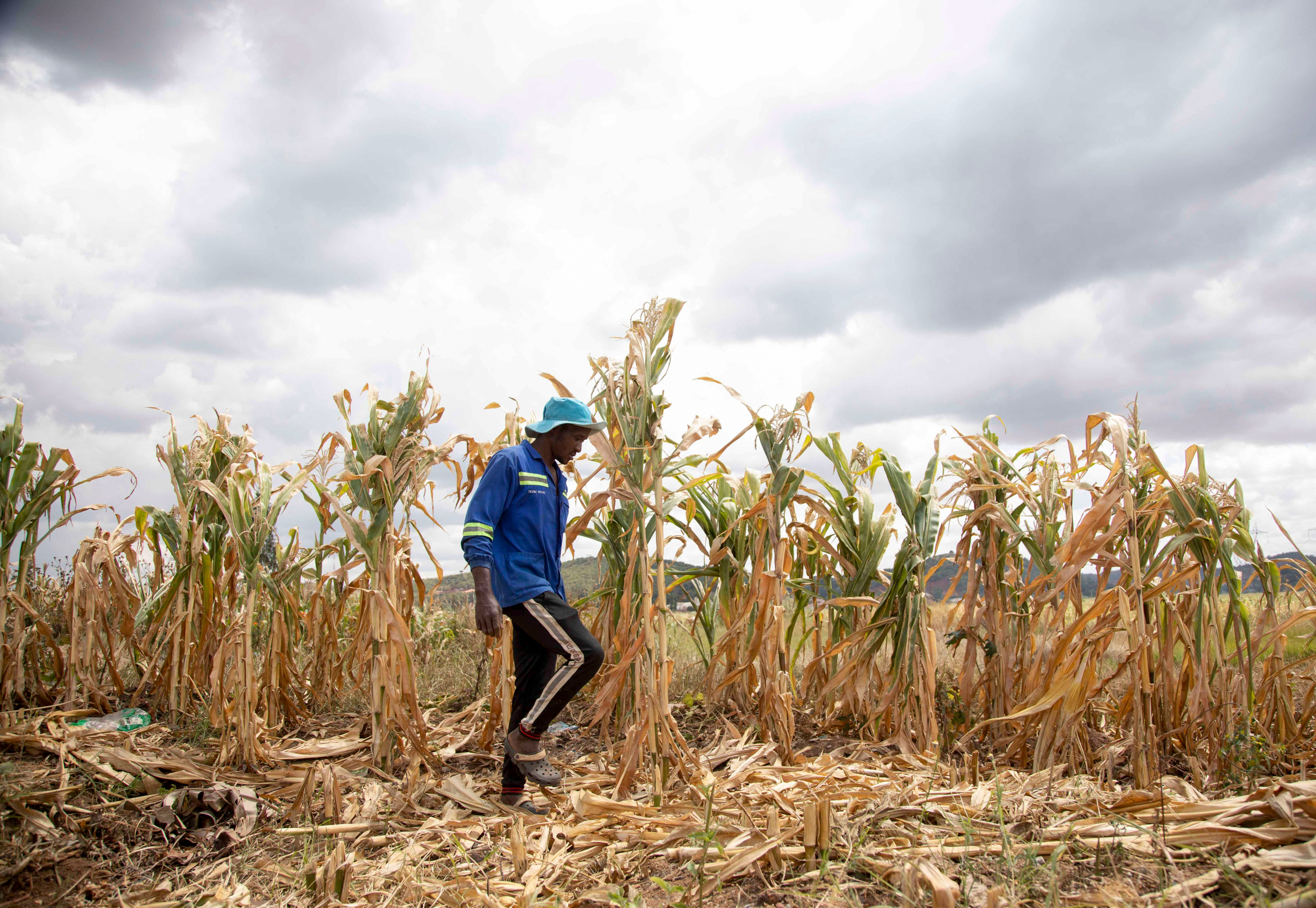The first three months of 2024 were not kind to farmers in Southern Africa. Malawi, Mozambique, Zambia and Zimbabwe all experienced an unusually dry February and one of the leanest rainy seasons in decades. As crops died in the fields, a food crisis loomed.
Felix Phikamiso, a farmer from the Ngabu traditional authority in south of Malawi, told Dialogue Earth the sun had scorched his entire maize field, and he arrival of rain in mid-March could not save the crop.
“Last year, we did not harvest because most of our gardens were washed away by Cyclone Freddy induced floods,” says Phikamiso. “I don’t think replanting this time will yield something.”
Meanwhile, to the north-west, in Zambia’s Eastern province, Janet Mwale watched helplessly as the maize she grew in the village of Chipwaira wilted and succumbed. Applying top dressing and basal fertilisers was not enough.
“We don’t know how we will feed ourselves because we only rely on farming,” she tells Dialogue Earth. “The dry spell has put us in a tight corner.”
A regional tragedy
The brutal drought has been brought on primarily by El Niño. This natural, recurring weather phenomenon raises surface temperatures across parts of the Pacific Ocean. These warmer patches impact weather patterns globally, including by lowering rain levels in Southern Africa.
El Niño is a climate pattern in which the surface water of the east-central tropical Pacific Ocean warms to significantly above average. This affects rainfall patterns and weather across the world, raising temperatures globally for its duration.
El Niño is part of a phenomenon called the El Niño–Southern Oscillation (ENSO). El Niño events do not occur on a regular schedule, but on average appear every two to seven years. The opposite, cooler phase is called La Niña.
During La Niña, cooler-than-average sea temperatures are experienced in the central and eastern equatorial Pacific. Like El Niño, it affects patterns of rainfall and atmospheric pressure worldwide.
The current reality in Southern Africa grimly reflects a November 2023 report by the Famine Early Warning Systems Network. It predicted that El Niño would cause scorching heat and significantly below-average rainfall across large swathes of Malawi, Mozambique, Zambia, South Africa, Zimbabwe and Madagascar.
Besides warning that El Niño would result in a meagre 2024 harvest for Malawi, Mozambique and Zimbabwe in particular, the report also expected the phenomenon to drive food insecurity in Southern Africa until the early months of 2025.
A study by World Weather Attribution found that the drought was mostly been driven by El Niño rather than climate change. “Over the past year, attribution studies have shown that many extreme weather events have been driven by a combination of both climate change and El Niño”, said Joyce Kimutai, an extreme weather researcher at Imperial College London’s Grantham Institute. However, “the Southern Africa drought appears to be a rarer example of an event fuelled primarily by El Niño,” she added.
As a result of the drought, the Famine Early Warning Systems Network expects staple food prices to be higher across the region than in both 2023 and the five-year average.
A combination of these high prices and low incomes is expected to suppress household purchasing power in the region.
The World Food Programme’s February 2024 “Southern Africa Seasonal Monitor” report concurred, saying rainfall deficits during the year’s first quarter would have substantial adverse impacts for harvests, and food security implications further into 2024.
Malawi, Zambia, Mozambique hit hard
The region’s political leaders have been speaking loud and clear on the crisis.
In March, Malawian president Lazarus Chakwera declared a State of Disaster in 23 of the country’s 28 districts. Close to two million farming households had been affected, he stated.
Maize supplies two-thirds of Malawians’ calorie intake, and Chakwera stated that nearly 750,000 hectares of the cereal crop have been affected, or 44.3% of the total maize area. “This extent of damage would require close to 600,000 metric tonnes of maize valued at MWK 357.6 billion [USD 205 million] for the humanitarian response,” he said.
Maize is also a staple in Zambia where President Hakainde Hichilema said 84 of 116 districts have been affected by drought, which had destroyed almost half of Zambia’s 2.2-million-hectare maize crop.
Beyond agriculture, Hichilema also highlighted the cascading implications for water and energy supplies: “This drought is having devastating consequences on many sectors such as agriculture, water availability, and energy supply, jeopardising our national food security and the livelihoods of millions of people.”
According to Hichilema, the drought will also impact hydropower, and the country could experience a deficit of 520 megawatts by December 2024.
In the meantime, the Zambian president hopes aid payments dedicated to agricultural production will ease food stress. However, it will likely take years for the country to recover from the impacts, such as on children’s nutrition, of a drought of this magnitude.
In 2015-2016, Mozamique suffered its worst drought in 35 years, with crops and livestock badly hit, and 1.5 million people plunged into food insecurity. This year, El Niño-induced drought could result in acute hunger for approximately 3.3 million in the country by September. Mozambique is also grappling with a conflict that has flared up in the northern province of Cabo Delgado, further jeopardising food supplies.
Adapt, educate, mitigate
Dialogue Earth consulted Horace Phiri, an agricultural economist and lecturer at Malawi’s Lilongwe University of Agriculture and Natural Resources (Luanar). He advocates for the advice and guidance of “agricultural extension” workers, whose knowledge can be applied to ease the effects of failed rains.
Phiri told Dialogue Earth that other crops can sometimes be planted instead of maize. “Different areas have different conditions, so farmers must be fully aware of what can work for them,” he says “That is why farmers need to consult; they should be cautious with the choice of seed by selecting drought-resistant crops.”
Innocent Phangaphanga, who directs thinktank the Luanar Centre for Agriculture Research and Development, says investments in agriculture will mitigate the impacts of future droughts. For example, the proliferation of Malawi’s Anchor Farm agronomic education model, as well as progress on plans to scale up agriculture in the country by creating “mega farms”. Phangaphanga also advises investment in irrigation and water-harvesting technologies, as well as a move to growing winter crops, raising drought-tolerant livestock and prioritising conservation-agriculture practices.
Of course, mitigating and adapting to drought requires funding. On 20 May, Angola’s president João Manuel Gonçalves Lourenço launched the Southern African Development Community’s regional humanitarian appeal, calling on member states, the international community and the private sector to provide at least USD 5.5 billion in aid. The intergovernmental coalition says more than 61 million people in the region have been affected by the extreme weather El Niño has brought.








